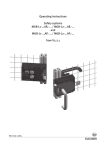Download Operating instructions CTP
Transcript
Operating instructions Transponder-Coded Safety Switch With Guard Locking CTP-AR Unicode/Multicode EN Operating instructions Transponder-Coded Safety Switch CTP-AR Contents 1. About this document.............................................................................................. 4 1.1. Scope.............................................................................................................................................4 1.2. Target group...................................................................................................................................4 1.3. Key to symbols................................................................................................................................4 1.4. Supplementary documents...............................................................................................................4 2. Correct use........................................................................................................... 5 3. Description of the safety function........................................................................... 6 4. Exclusion of liability and warranty.......................................................................... 7 5. General safety instructions.................................................................................... 7 6. Function................................................................................................................ 8 7. 6.1. Guard lock monitoring......................................................................................................................8 6.2. Door monitoring output (OD).............................................................................................................8 6.3. Diagnostics output (OI).....................................................................................................................8 6.4. Guard locking monitoring output (OL)................................................................................................8 6.5. Guard locking on version CTP‑L1.......................................................................................................8 6.6. Guard locking on version CTP‑L2.......................................................................................................9 6.7. Switching states..............................................................................................................................9 Manual release.................................................................................................... 10 7.1. 7.2. 7.3. 7.4. Mechanical release and mechanical key release (can be retrofitted)...................................................10 7.1.1. Actuating mechanical release.............................................................................................10 7.1.2. Actuating mechanical key release.......................................................................................10 Emergency unlocking (can be retrofitted).........................................................................................11 7.2.1. Actuating emergency unlocking..........................................................................................11 Escape release (optional)...............................................................................................................11 7.3.1. Actuating escape release..................................................................................................11 Wire front release (optional)............................................................................................................12 7.4.1. Laying wire front release...................................................................................................12 8. Changing the approach direction......................................................................... 13 9. Mounting............................................................................................................. 14 10. Electrical connection........................................................................................... 15 2 10.1. Notes about ..........................................................................................................................16 10.2. Safety in case of faults...................................................................................................................16 10.3. Fuse protection for power supply....................................................................................................16 10.4. Requirements for connection cables................................................................................................17 10.5. Maximum cable lengths..................................................................................................................18 10.5.1. Determining cable lengths using the example table..............................................................19 (translation of the original operating instructions) 123041-03-07/15 Operating instructions Transponder-Coded Safety Switch CTP-AR 10.6. Pin assignment safety switch CTP‑…‑AR‑…‑SAB‑… with plug connectors 2 x M12...............................20 10.7. Pin assignment safety switch CTP‑…‑AR‑…‑SH‑… with plug connector M23 (RC18).............................20 10.8. Connector assignment for Y-distributor............................................................................................21 10.9. Connection of a single CTP‑AR........................................................................................................22 10.10. Connection of several CTP‑AR in a switch chain.................................................................................. 23 10.11. Notes on operation with safe control systems..................................................................................25 11. Setup.................................................................................................................. 27 11.1. LED indicators...............................................................................................................................27 11.2. Teach-in function for actuator (only for unicode evaluation)................................................................27 11.2.1. Teaching-in actuator..........................................................................................................28 11.2.2. Teach-in function with series connection, replacing and teaching in device.............................28 Functional check............................................................................................................................29 11.3.1. Mechanical function test....................................................................................................29 11.3.2. Electrical function test.......................................................................................................29 11.3. 12. System status table............................................................................................. 30 13. Technical data..................................................................................................... 31 13.1. 13.2. 13.3. Technical data for safety switch CTP‑AR...........................................................................................31 13.1.1. Typical system times.........................................................................................................32 Dimension drawing safety switch CTP…..........................................................................................33 Technical data for actuator CTP‑.....................................................................................................35 13.3.1. Dimension drawing for actuator CTP‑..................................................................................35 14. Ordering information and accessories.................................................................. 38 15. Inspection and service......................................................................................... 38 16. Service............................................................................................................... 38 17. Declaration of conformity.................................................................................... 39 EN 123041-03-07/15 (translation of the original operating instructions) 3 Operating instructions Transponder-Coded Safety Switch CTP-AR 1. About this document 1.1. Scope These operating instructions are valid for all CTP‑L.‑AR… from version V1.0.0. These operating instructions together with document "Safety Information and Maintenance" as well as any data sheet enclosed form the complete user information for your device. 1.2. Target group Design engineers and installation planners for safety devices on machines, as well as setup and servicing staff possessing special expertise in handling safety components. 1.3. Key to symbols Symbol/depiction Significance Printed document www t ne er Int Document is available for download at www.EUCHNER.de Document on CD MEM DANGER WARNING CAUTION NOTICE Important! Tip 1.4. This section is applicable only if the memory card is used Safety precautions Danger of death or severe injuries Warning about possible injuries Caution minor injuries possible Notice about possible device damage Important information Tip/useful information Supplementary documents The overall documentation for this device consists of the following documents: Document title (document number) Contents Safety Information and Maintenance CTP (105517) Basic information on safe setup and service Operating instructions (123041) (this document) Possibly enclosed data sheet Item-specific information about deviations or additions Important! Always read all documents to gain a complete overview of safe installation, setup and use of the device. The documents can be downloaded from www.euchner.de. For this purpose enter the doc. no. in the search box. 4 (translation of the original operating instructions) 123041-03-07/15 Operating instructions Transponder-Coded Safety Switch CTP-AR 2. Correct use Safety switches series CTP‑L.-… are interlocking devices with guard locking (type 4). Devices with unicode evaluation possess a high coding level; devices with multicode evaluation feature a low coding level. In combination with a movable safety guard and the machine control, this safety component prevents the safety guard from being opened while a dangerous machine function is being performed. This means: ÌÌStarting commands that cause a dangerous machine function must become active only when the safety guard is closed and locked. ÌÌThe guard locking device must not be unlocked until the dangerous machine function has ended. ÌÌClosing and locking a safety guard must not cause automatic starting of a dangerous machine function. A separate start command must be issued. For exceptions, refer to EN ISO 12100 or relevant C‑standards. Devices from this series are also suitable for process protection. Before the device is used, a risk assessment must be performed on the machine, e.g. in accordance with the following standards: ÌÌEN ISO 13849‑1, Safety of machinery – Safety-related parts of control systems – Part 1: General principles for design ÌÌEN ISO 12100, Safety of machinery – General principles for design – Risk assessment and risk reduction ÌÌIEC 62061, Safety of machinery – Functional safety of safety-related electrical, electronic and programmable electronic control systems Correct use includes observing the relevant requirements for installation and operation, particularly based on the following standards: ÌÌEN ISO 13849‑1, Safety of machinery – Safety-related parts of control systems – Part 1: General principles for design ÌÌEN ISO 14119 (supersedes EN 1088), Safety of machinery – Interlocking devices associated with guards – Principles for design and selection ÌÌEN 60204‑1, Safety of machinery. Electrical equipment of machines. General requirements. The safety switch is only allowed to be operated in conjunction with the intended EUCHNER actuators and the related connection components from EUCHNER. On the use of different actuators or other connection components, EUCHNER provides no warranty for safe function. Connection of several devices in an AR switch chain is permitted only using devices intended for series connection in an AR switch chain. Check this in the instructions of the device in question. A maximum of 20 safety switches are allowed to be operated in a switch chain. Important! ÌÌThe user is responsible for the proper integration of the device into a safe overall system. For this purpose, the overall system must be validated, e.g. in accordance with EN ISO 13849‑2. ÌÌIt is only allowed to use components that are permissible in accordance with the table below. Table 1: Possible combinations for CTP components Actuator EN Safety switch A-C-H-... CTP‑… Unicode/Multicode Key to symbols Combination possible 123041-03-07/15 (translation of the original operating instructions) 5 Operating instructions Transponder-Coded Safety Switch CTP-AR NOTICE For information about combination with an AR evaluation unit, please refer to chapter 10.10. Connection of several CTP‑AR in a switch chain on page 23. 3. Description of the safety function Devices from this series feature the following safety functions: Monitoring of guard locking and the position of the safety guard (interlocking device with guard locking according to EN ISO 14119) ÌÌSafety function (see chapter 6.7. Switching states on page 9): -- The safety outputs are switched off when guard locking is unlocked (monitoring of the locking device). -- The safety outputs are switched off when the safety guard is open (monitoring of the door position). -- Guard locking can be activated only when the actuator is located in the switch head (failsafe locking mechanism). ÌÌSafety characteristics: Category, Performance Level, PFHd (see chapter 13. Technical data on page 31). Control of guard locking If the device is used as guard locking for personnel protection, control of guard locking must be regarded as a safety function. The device does not feature a safety characteristic for control of guard locking, because the guard locking solenoid is completely disconnected from the outside (no control function within the device). It therefore does not contribute to the failure probability. The safety level for the control of the guard locking is only defined by the external control (e. g. PFHd, ext. for the standstill monitor). Guardlocking Device PFHdext. (e.g. standstill monitor) 6 (locking mean) (translation of the original operating instructions) 123041-03-07/15 Operating instructions Transponder-Coded Safety Switch CTP-AR 4. Exclusion of liability and warranty In case of failure to comply with the conditions for correct use stated above, or if the safety instructions are not followed, or if any servicing is not performed as required, liability will be excluded and the warranty void. 5. General safety instructions Safety switches provide personal protection functions. Incorrect installation or tampering can lead to fatal injuries to personnel. Check the safe function of the safety guard particularly ÌÌafter any setup work ÌÌafter the replacement of a system component ÌÌafter an extended period without use ÌÌafter every fault Independent of these checks, the safe function of the safety guard should be checked at suitable intervals as part of the maintenance schedule. WARNING Danger to life due to improper installation or due to bypassing (tampering). Safety components perform a personal protection function. ÌÌSafety components must not be bypassed, turned away, removed or otherwise rendered ineffective. On this topic pay attention in particular to the measures for reducing the possibility of bypassing according to EN ISO 14119:2013, section 7. ÌÌThe switching operation must be triggered only by actuators designated for this purpose. ÌÌPrevent bypassing by means of replacement actuators (only for multicode evaluation). For this purpose, restrict access to actuators and to keys for releases, for example. ÌÌMounting, electrical connection and setup only by authorized personnel possessing the following knowledge: -- specialist knowledge in handling safety components -- knowledge about the applicable EMC regulations -- knowledge about the applicable regulations on occupational safety and accident prevention. Important! Prior to use, read the operating instructions and keep these in a safe place. Ensure the operating instructions are always available during mounting, setup and servicing. EUCHNER cannot provide any warranty in relation to the readability of the CD for the storage period required. For this reason you should archive a printed copy of the operating instructions. You can download the operating instructions from www.EUCHNER.de. EN 123041-03-07/15 (translation of the original operating instructions) 7 Operating instructions Transponder-Coded Safety Switch CTP-AR 6. Function The device permits the locking of movable safety guards. The system consists of the following components: coded actuator (transponder) and switch. Transponder-coded actuator Whether the complete actuator code of the device is taught in (unicode) or not (multicode) depends on the respective version. Guard locking pin ÌÌDevices with unicode evaluation: The actuator must be assigned to the safety switch by a teach-in operation so that it is detected by the system. This unambiguous assignment ensures a particularly high level of protection against tampering. The system thereby possesses a high coding level. ÌÌDevices with multicode evaluation: Unlike systems with unique code detection, on multicode devices a specific code is not polled but instead it is only checked whether the actuator is of a type that can be detected by the system (multicode detection). There is no exact comparison of the actuator code with the taught-in code in the safety switch (unique code detection). The system possesses a low coding level. When the safety guard is closed, the actuator is moved into the safety switch. When the switch-on distance is reached, power is supplied to the actuator via the switch and data transfer takes place. If a permissible code is detected, the safety outputs The safety outputs are switched on. and the monitoring output (OL) are switched off when the safety guard is opened. In the event of a fault in the safety switch, the safety outputs are switched off and the DIA LED illuminates red. The occurrence of failures is detected at the latest on the next demand to close the safety outputs (e.g. on starting). 6.1. Guard lock monitoring All versions feature two safe outputs for monitoring guard locking. The safety outputs off when guard locking is released. 6.2. (FO1A and FO1B) are switched Door monitoring output (OD) All versions have a door monitoring output. The door monitoring output is switched on as soon as the actuator is inserted in the switch head (state: safety guard closed and not locked). The door monitoring output also remains switched on when guard locking is active. 6.3. Diagnostics output (OI) The diagnostics output is switched on in the event of a fault (switch-on condition as for DIA LED). 6.4. Guard locking monitoring output (OL) The guard locking monitoring output is switched on when guard locking is active. 6.5. Guard locking on version CTP‑L1 (guard locking actuated by spring force and released by energy ON) Activating guard locking: close safety guard; no voltage at the solenoid. Releasing guard locking: apply voltage to the solenoid. The spring-operated guard locking functions in accordance with the closed-circuit current principle. If voltage is interrupted at the solenoid, guard locking remains active and the safety guard cannot be opened directly. Important! If the safety guard is open when the power supply is interrupted and the guard is then closed, guard locking is activated. This can lead to persons being locked in unintentionally. The actuator cannot be pulled out of the switch and the safety guard is locked as long as the guard locking pin is extended. If voltage is applied to the guard locking solenoid, the guard locking pin is retracted and the actuator is released. The safety guard can be opened. 8 (translation of the original operating instructions) 123041-03-07/15 Operating instructions Transponder-Coded Safety Switch CTP-AR 6.6. Guard locking on version CTP‑L2 (guard locking actuated by energy ON and released by spring force) Important! Use as guard locking for personnel protection is possible only in special cases, after strict assessment of the accident risk (see EN ISO 14119:2013, section 5.7.1)! Activating guard locking: apply voltage to the solenoid. Releasing guard locking: disconnect voltage from the solenoid. The magnetically actuated guard locking operates in accordance with the open-circuit current principle. If voltage is interrupted at the solenoid, guard locking is released and the safety guard can be opened directly! The safety guard can be opened as long as no voltage is applied to the guard locking solenoid. If voltage is applied to the guard locking solenoid, the guard locking pin is held in the extended position and the safety guard is locked. 6.7. Switching states The detailed switching states for your switch can be found in the system status table. All safety outputs, monitoring outputs and indicating LEDs are described there. Safety guard closed and locked IMP IMM Safety guard closed and not locked IMP IMM Safety guard open IMP IMM Voltage on the guard locking solenoid CTP‑L1 off on (irrelevant) Voltage on the guard locking solenoid CTP-L2 on off (irrelevant) Safety outputs FO1A and FO1B on off off Guard locking monitoring output OL on off off Door monitoring output OD on on off EN 123041-03-07/15 (translation of the original operating instructions) 9 Operating instructions Transponder-Coded Safety Switch CTP-AR 7. Manual release Some situations require guard locking to be released manually (e.g. malfunctions or an emergency). A function test should be performed after release. More information on this topic can be found in the standard EN ISO 14119:2013, section 5.7.5.1. The device can feature the following release functions: 7.1. Mechanical release and mechanical key release (can be retrofitted) In the event of malfunctions, the guard locking can be released with the mechanical release irrespective of the state of the solenoid. The safety outputs stop command. are switched off when the mechanical release is actuated. Use the safety outputs to generate a The monitoring output OL is switched off; OD can assume an undefined state. Open the safety guard and close it again after resetting the mechanical release. The device will then operate normally again. 7.1.1. Actuating mechanical release 1. Unscrew locking screw 2. Using a screwdriver, turn the mechanical release to in the direction of the arrow ¨¨ Guard locking is released. Mechanical release Important! ÌÌThe actuator must not be under tensile stress during manual release. ÌÌAfter use, reset the mechanical release and screw in and seal the Locking screw locking screw (for example with sealing lacquer). ÌÌThe mechanical key release must not be used to lock the switch during servicing to prevent activation of guard locking, for example. ÌÌLoss of the unlocking function due to mounting errors or damage during mounting. ÌÌCheck the release function every time after mounting. ÌÌPlease observe the notes on any enclosed data sheets. 7.1.2. Actuating mechanical key release On devices with mechanical key release (can be retrofitted), simply turn the key to release. Function as for mechanical release. For mounting, see the mechanical key release supplement. 10 (translation of the original operating instructions) 123041-03-07/15 Operating instructions Transponder-Coded Safety Switch CTP-AR 7.2. Emergency unlocking (can be retrofitted) Permits opening of a locked safety guard from outside the danger area without tools. For mounting, see the mounting supplement. Important! ÌÌIt must be possible to operate emergency unlocking manually from outside the protected area without tools. ÌÌEmergency unlocking must possess a marking indicating that it may be used only in an emergen- cy. ÌÌThe actuator must not be under tensile stress during manual release. ÌÌThe unlocking function meets all other requirements from EN ISO 14119. ÌÌEmergency unlocking meets the requirements of Category B according to EN ISO 13849‑1:2008. ÌÌLoss of the unlocking function due to mounting errors or damage during mounting. ÌÌCheck the release function every time after mounting. ÌÌPlease observe the notes on any enclosed data sheets. 7.2.1. Actuating emergency unlocking ÌÌTurn emergency unlocking clockwise until it clicks into place. ¨¨ Guard locking is released. To reset, press the snap-in bolt inward using a small screwdriver or similar tool and turn the emergency unlocking back. Snap-in bolt The safety outputs are switched off when emergency unlocking is actuated. Use the safety outputs to generate a stop command. The monitoring output OL is switched off; OD can assume an undefined state. Open the safety guard and close it again after resetting emergency unlocking. The device will then operate normally again. 7.3. Escape release (optional) Permits opening of a locked safety guard from the danger area without tools (see chapter 13.2. Dimen‑ sion drawing safety switch CTP… on page 33). Important! ÌÌIt must be possible to operate the escape release manually from inside the protected area without tools. ÌÌIt must not be possible to reach the escape release from the outside. ÌÌThe actuator must not be under tensile stress during manual release. ÌÌThe escape release meets the requirements of Category B according to EN ISO 13849‑1:2008. 7.3.1. Actuating escape release ÌÌPress the red release knob to the end stop EN ¨¨ Guard locking is released. Pull the knob out again to reset. The safety outputs command. are switched off when the escape release is actuated. Use the safety outputs to generate a stop The monitoring output OL is switched off; OD can assume an undefined state. Open the safety guard and close it again after resetting escape release. The device will then operate normally again. 123041-03-07/15 (translation of the original operating instructions) 11 Operating instructions Transponder-Coded Safety Switch CTP-AR 7.4. Wire front release (optional) Release via a pull wire. Depending on the type of attachment, the wire front release can be used as emergency unlocking or escape release. The following applies to non-latching wire front releases: If the unlocking device is to be used for emergency unlocking, you must take one of the following measures (see EN ISO 14119:2013, section 5.7.5.3): ÌÌMount the unlocking device such that reset can only be undertaken with the aid of a tool. ÌÌAlternatively, the reset can be undertaken at the control system level. E. g. by means of a plausibility check (status of the safety outputs does not match the guard locking control signal). The emergency-unlocking specifications in chapter 7.2 on Page 11 apply irrespective of this. Important! ÌÌThe wire front release meets the requirements of Category B according to EN ISO 13849‑1:2008. ÌÌThe correct function depends on the laying of the pull wire and on the attachment of the pull handle, and this is the responsibility of the plant manufacturer. ÌÌThe actuator must not be under tensile stress during manual release. 7.4.1. Laying wire front release Important! ÌÌLoss of the release function due to mounting errors, damage or wear. ÌÌCheck the release function every time after mounting. ÌÌWhen routing the wire front release, ensure that it operates smoothly. ÌÌObserve the min. bending radius (100 mm) and minimize the number of bends. ÌÌThe switch is not allowed to be opened. ÌÌObserve the notes on the enclosed data sheets. 12 (translation of the original operating instructions) 123041-03-07/15 Operating instructions Transponder-Coded Safety Switch CTP-AR 8. Changing the approach direction The approach direction only needs to be changed if the switch is to be approached from the rear. Proceed as follows: 1. Remove the screws from the safety switch 2. Set the required direction 3. Tighten the screws with a torque of 1.2 Nm D A C B Figure 1: Changing the approach direction EN 123041-03-07/15 (translation of the original operating instructions) 13 Operating instructions Transponder-Coded Safety Switch CTP-AR 9. Mounting CAUTION Safety switches must not be bypassed (bridging of contacts), turned away, removed or otherwise rendered ineffective. ÌÌObserve EN ISO 14119:2013, section 7, for information about reducing the possibilities for bypassing an interlocking device. NOTICE Risk of damage to equipment and malfunctions as a result of incorrect installation. ÌÌSafety switches and actuators must not be used as an end stop. ÌÌObserve EN ISO 14119:2013, sections 5.2 and 5.3, for information about fastening the safety switch and the actuator. ÌÌProtect the switch head against damage as well as penetrating foreign objects such as swarf, sand and blasting shot, etc. ÌÌObserve the min. door radii (see chapter 13.3.1. Dimension drawing for actuator CTP‑... on page 35). A clearance of 12 mm must be maintained around the actuator head (see Figure 2). The mounting aid provided can be used to check this clearance. Mounting aid min. 12 Figure 2: 14 min. 12 12 Mounting aid Actuator head clearance and mounting aid (translation of the original operating instructions) 123041-03-07/15 Operating instructions Transponder-Coded Safety Switch CTP-AR 10. Electrical connection The following connection options are available: ÌÌSeparate operation ÌÌSeries connection with Y-distributors from EUCHNER (only with M12 plug connector) ÌÌSeries connection, e.g. with wiring in the control cabinet. ÌÌOperation on an AR evaluation unit. WARNING In case of an error, loss of the safety function through incorrect connection. ÌÌTo ensure safety, both safety outputs (FO1A and FO1B) must always be evaluated. ÌÌMonitoring outputs must not be used as safety outputs. ÌÌLay the connection cables with protection to prevent the risk of short circuits. CAUTION Risk of damage to equipment or malfunctions as a result of incorrect connection. ÌÌThe power supply for the evaluation electronics is electrically isolated from the power supply for the guard locking solenoid. ÌÌDo not use a control system with pulsing or switch off the pulsing function in your control system. The device generates its own test pulses on the output lines FO1A/FO1B. A downstream control system must tolerate these test pulses, which may be up to 1 ms long on AR devices. The test pulses on AR devices are also output when the safety outputs are switched off. Depending on the inertia of the connected device (control system, relay, etc.), this can lead to short switching processes. ÌÌThe inputs on an evaluation unit connected must be positive-switching, as the two outputs on the safety switch deliver a level of +24 V in the switched-on state. ÌÌAll the electrical connections must either be isolated from the mains supply by a safety transformer according to IEC 61558‑2‑6 with limited output voltage in the event of a fault, or by other equivalent isolation measures (PELV). ÌÌAll electrical outputs must have an adequate protective circuit for inductive loads. The outputs must be protected with a free-wheeling diode for this purpose. RC interference suppression units must not be used. ÌÌPower devices which are a powerful source of interference must be installed in a separate location away from the input and output circuits for signal processing. The cable routing for safety circuits should be as far away as possible from the cables of the power circuits. ÌÌIn order to avoid EMC interference, the physical environmental and operating conditions at the installation site of the device must comply with the requirements according to the standard EN 60204-1:2006, section 4.4.2 (EMC). CAUTION Please pay attention to any interference fields in case of devices such as frequency converters or induction heating systems. Observe the EMC instructions in the manuals from the respective manufacturer. Important! If the device does not appear to function when operating voltage is applied (e.g. green STATE LED does not flash), the safety switch must be returned unopened to the manufacturer. 123041-03-07/15 (translation of the original operating instructions) 15 EN Operating instructions Transponder-Coded Safety Switch CTP-AR 10.1. Notes about Important! ÌÌFor use and operation as per the requirements 1), a power supply with the feature “for use in class 2 circuits” must be used. Alternative solutions must comply with the following requirements: a) Electrically isolated power supply unit with a max. open-circuit voltage of 30 V/DC and a limited current of max. 8 A. b) Electrically isolated power supply unit in combination with fuse as per UL248. This fuse should be designed for max. 3.3 A and should be integrated into the 30 V DC voltage section. ÌÌFor use and applications as per the requirements 1), a connection cable listed under the UL category code CYJV/7 must be used. 1) Note on the scope of the UL approval: The devices are tested according to the requirements of UL508 and CSA/ C22.2 no. 14 (protection against electric shock and fire). 10.2. Safety in case of faults ÌÌThe operating voltage UB and the solenoid voltage IMP are reverse polarity protected. ÌÌThe safety outputs FO1A/FO1B are short circuit-proof ÌÌA short circuit between FO1A and FO1B is detected by the switch. ÌÌA short circuit in the cable can be excluded by laying the cable with protection. 10.3. Fuse protection for power supply The power supply must be provided with fuse protection depending on the number of switches and current required for the outputs. The following rules apply: Max. current consumption of an individual switch Imax Imax = IUB + IFO1A+FO1B + IOL + IOD IUB = Switch operating current (40 mA) IOL/IOD = Load current of monitoring outputs (max. 50 mA per monitoring output) IFO1A+FO1B = Load current of safety outputs FO1A + FO1B (2 x max. 150 mA) Max. current consumption of a switch chain Σ Imax Σ Imax = IFO1A+FO1B + n x (IUB + IOL + IOD) n 16 = Number of connected switches (translation of the original operating instructions) 123041-03-07/15 Operating instructions Transponder-Coded Safety Switch CTP-AR 10.4. Requirements for connection cables CAUTION Risk of damage to equipment or malfunctions as a result of incorrect connection cables. ÌÌUse connection components and connection cables from EUCHNER. ÌÌOn the usage of other connection components, the requirements in the following table apply. EUCHNER provides no warranty for safe function in case of failure to comply with these requirements. Observe the following requirements with respect to the connection cables: For safety switches CTP‑…‑AR‑…‑SAB‑… with plug connectors 2 x M12 Parameter Value Unit Conductor cross-section min. 0.34 mm² R max. 60 W/km C max. 120 nF/km 0.65 mH/km L max. Recommended cable type LIYY 8x or 5x0.34 mm² For safety switches CTP‑…‑AR‑…‑SH‑… with plug connector M23 (RC18) Parameter Value Unit Conductor cross-section min. 0.34 mm² R max. 60 W/km C max. 120 nF/km 0.65 mH/km L max. Recommended cable type LIFY11Y min. 12-core EN 123041-03-07/15 (translation of the original operating instructions) 17 Operating instructions Transponder-Coded Safety Switch CTP-AR 10.5. Maximum cable lengths Switch chains are permitted up to a maximum overall cable length of 200 m taking into account the voltage drop as a result of the cable resistance (see table below with example data and case example). lmax =200 m l2 l1 ln un = 24 V -20% umin = 24 V -10% iout SPS PLC 5 x 0,34 mm2 CES-AR # 1 CES-AR # n-1 CTP-AR # n n IFO1A/FO1B (mA) l1 (m) Max. number of switches Possible output current per channel FO1A/FO1B Max. cable length from the last switch to the control system 10 150 25 100 50 80 100 50 5 6 10 18 150 25 10 120 25 90 50 70 100 50 150 25 10 70 25 60 50 50 100 40 150 25 (translation of the original operating instructions) 123041-03-07/15 Operating instructions Transponder-Coded Safety Switch CTP-AR 10.5.1. Determining cable lengths using the example table Example: 6 switches are to be used in series. Cabling with a length of 40 m is routed from a safety relay in the control cabinet to the last switch (#6). Cables with a length of 20 m each are connected between the individual CES‑AR/CTP‑L1‑… safety switches. l = 140 m l2 = 5 x 20 m l1 = 40 m ln = 20 m un = min. 19,2 V iOA/OB = 75 mA Sicherheitsrelais Safety Relay CES-AR # 1 CES-AR # 2 CES-AR # 3 CES-AR # 5 CTP-AR # 4 Figure 3: CTP-AR # 6 Circuit example with six CES‑AR/CTP‑L1‑… A safety relay is connected downstream which consumes 75 mA on each of the two safety inputs. This operates over the whole temperature range with a voltage of 19.2 V (corresponds to 24 V -20%). All the relevant values can now be determined using the example table: 1. Select the corresponding section in the column n (max. number of switches). Here: 6 switches. 2. In column IFO1A/FO1B (possible output current per channel FO1A/FO1B), find a current greater than or equal to 75 mA. Here: 100 mA. ¨¨ It is then possible to determine the maximum cable length from the last switch (#6) to the control system from column l1. Here: a length of 50 m is permitted. Result: The desired cable length l1 of 40 m is below the permitted value from the table. The overall length of the switch chain lmax of 140 m is less than the maximum value of 200 m. ¨¨ The planned application is therefore functional in this form. EN 123041-03-07/15 (translation of the original operating instructions) 19 Operating instructions Transponder-Coded Safety Switch CTP-AR 10.6. Pin assignment safety switch CTP‑…‑AR‑…‑SAB‑… with plug connectors 2 x M12 Wiring diagram A Plug connector (view of connection side) Pin Designation Function X 1.1 FI1B Enable input for channel 2 X 1.2 UB Operating voltage of AR electronics, 24 V DC X 1.3 FO1A X1.7 X 1.4 FO1B X1.6 X 1.5 OL 2 x M12 X1.1 X1.2 X1.3 X1.4 X1.5 X1.8 X2.5 X2.1 X2.2 X2.4 X2.3 Safety output, channel 1 Safety output, channel 2 Guard locking monitoring output Wire color Connection cable WH 1) BN GN YE GY X 1.6 FI1A Enable input for channel 1 PK X 1.7 0 V UB Operating voltage of AR electronics 0 V BU X 1.8 RST Reset input RD X 2.1 IMM Operating voltage of guard locking solenoid 0 V BN X 2.2 OD Door monitoring output WH X 2.3 OI Diagnostics output BU X 2.4 IMP Operating voltage of guard locking solenoid, 24 V DC BK X 2.5 - Not used GY 1) Only for standard EUCHNER connection cable 10.7. Pin assignment safety switch CTP‑…‑AR‑…‑SH‑… with plug connector M23 (RC18) Wiring diagram B Plug connector (view of connection side) M23 (RC18) With screen bonding clamp 12 11 10 9 17 18 19 16 1 13 14 15 8 7 6 2 3 4 5 Wire color Connection cable Pin Designation Function 1 IMP Operating voltage of guard locking solenoid, 24 V DC VT 2 FI1A Enable input for channel 1 RD 3 FI1B Enable input for channel 2 4 FO1A Safety output, channel 1 RD/BU 5 FO1B Safety output, channel 2 GN 6 UB Operating voltage of AR electronics, 24 V DC BU 7 RST Reset input GY/PK 8 OD Door monitoring output GN/WH 9 OI Diagnostics output YE/WH 10 OL Guard locking monitoring output GY/WH 1) GY 11 - n.c. BK 12 FE Function earth (must be connected to meet the EMC requirements) GN/YE 13 - n.c. PK 14 - n.c. BN/GY 15 - n.c. BN/YE 16 - n.c. BN/GN WH 17 - n.c. 18 IMM Operating voltage of guard locking solenoid 0 V YE 19 0 V UB Operating voltage of AR electronics 0 V BN 1) Only for standard EUCHNER connection cable 20 (translation of the original operating instructions) 123041-03-07/15 Operating instructions Transponder-Coded Safety Switch CTP-AR 10.8. Connector assignment for Y-distributor (only for version with plug connectors 2 x M12) Pin assignment for safety switch CTP‑L1‑… (plug X1, 8‑pin plug) and Y‑distributor (8‑pin socket) Pin Function X1.1 FI1B X1.2 UB X1.3 FO1A X1.4 FO1B X1.5 OL X1.6 FI1A X1.7 0V X1.8 RST Y‑distributor with connecting cable 111696 or 112395 Strapping plug 097645 4‑pin, plug (figure similar) Socket 2 3 4 1 5 8 6 7 M12x1 M12x1 Length l max. 45 45 15 41 15 Order No. Length l [mm] 111696 200 112395 1000 33 A 44 Ø 14,5 B M 12x1 M12x1 15 Plug 2 3 2 3 Socket 5 5 4 4 1 1 Pin Function Pin Function X2.1 UB X3.1 UB X2.2 FO1A X3.2 FI1A X2.3 0V X3.3 0V X2.4 FO1B X3.4 FI1B X2.5 RST X3.5 RST 123041-03-07/15 (translation of the original operating instructions) EN 21 Operating instructions Transponder-Coded Safety Switch CTP-AR 10.9. Connection of a single CTP‑AR If a single CTP‑AR is used, connect the switch as shown in Figure 4. The monitoring outputs can be routed to a control system. The switches can be reset via the RST input. To do this, a voltage of 24 V is applied to the RST input for at least 3 s. The RST input must be connected to 0 V if it is not used. WARNING In case of an error, loss of the safety function through incorrect connection. ÌÌTo ensure safety, both safety outputs (FO1A and FO1B) must always be evaluated. Important! ÌÌThe example shows only an excerpt that is relevant for connection of the CTP system. The example illustrated here does not show complete system planning. The user is responsible for safe integration in the overall system. Detailed application examples can be found at www.EUCHNER.de. Simply enter the order number of your switch in the search box. All available connection examples for the device can be found under “Downloads.” 24V DC 1 -F1 -F2 2 -B1 CTP 24V / 1 2 IMP UB X2:4 RST X1:2 FI1A X1:8 X1:6 FI1B X1:1 Actuator Safety inputs Monitoring outputs Read head Door monitoring X2:1 IMM X2:5 NC X1:7 0V UB X2:2 OD Guardlocking active Diagnostics X1:5 X2:3 OL OI Safety outputs X1:3 X1:4 FO1A FO1B Connected load 0V Figure 4: 22 0V / Connection example for separate operation, version with plug connectors 2xM12 (translation of the original operating instructions) 123041-03-07/15 Operating instructions Transponder-Coded Safety Switch CTP-AR 10.10. Connection of several CTP‑AR in a switch chain Important! ÌÌAn AR switch chain may contain a maximum of 20 safety switches. ÌÌThe example shows only an excerpt that is relevant for connection of the CTP system. The ex- ample illustrated here does not show complete system planning. The user is responsible for safe integration in the overall system. Detailed application examples can be found at www.EUCHNER. de. Simply enter the order number of your switch in the search box. You will find all available connection examples for the device in Downloads. The series connection is shown here based on the example of the version with plug connectors 2 x M12. The series connection of the version with plug connector RC18 has similar behavior, but is realized using additional terminals in a control cabinet. The switches in the version with plug connectors 2 x M12 are connected one after the other with the aid of pre-assembled connection cables and Y-distributors. If a safety guard is opened or if a fault occurs on one of the switches, the system shuts down the machine. A higher level control system cannot, however, detect which safety guard is open or on which switch a fault has occurred with this connection technology. The safety outputs are permanently assigned to the respective safety inputs of the downstream switch. FO1A must be routed to FI1A and FO1B to FI1B. If the connections are interchanged (e. g. FO1A to FI1B), the unit will switch to the fault state. Always use the RST input in series connections. All switches in a chain can be reset at the same time with this reset input. To do this, a voltage of 24 V must be applied to the RST input for at least 3 s. If input RST is not used in your application, it should be connected to 0 V. Note the following on this aspect: ÌÌA common signal must be used for all switches in the chain. This can be a changeover switch or the output of a control system. A button is not suitable because Reset must always be connected to GND during operation (see switch S11 in Figure 5 on page 24). ÌÌReset must always be performed simultaneously for all switches of the chain. EN 123041-03-07/15 (translation of the original operating instructions) 23 -B1 Terminating plug FI1B 6 FI1A Safety inputs 1 Read head 24 8 RST 2 +UB 7 5 CES 0V Y distributor OD FO1A 4 FO1B Safety outputs 3 -B2 FI1B 6 FI1A Safety inputs 1 Read head Figure 5: 8 RST 2 +UB 7 5 CES 0V Y distributor OD FO1A 4 FO1B Safety outputs 3 -B3 FI1B FI1A X1:6 Safety inputs X1:1 RST X1:8 X1:2 UB OL X1:5 Read head X1:7 0V UB Y distributor Actuator FO1A FO1B X1:4 CTP Safety outputs X1:3 IMM X2:1 X2:4 IMP 13 14 X2:2 OD -S1 OI X2:3 NC X2:5 11 -S2 14 12 RESET Connected load 24V / 0V / Operating instructions Transponder-Coded Safety Switch CTP-AR Connection example for operation in a CES‑AR switch chain (translation of the original operating instructions) 123041-03-07/15 Operating instructions Transponder-Coded Safety Switch CTP-AR 10.11. Notes on operation with safe control systems Please observe the following requirements for connection to safe control systems: ÌÌUse a common power supply for the control system and the connected safety switches. ÌÌA pulsed power supply must not be used for UB. Tap the supply voltage directly from the power supply unit. If the supply voltage is connected to a terminal of a safe control system, this output must provide sufficient electrical current. ÌÌAlways connect inputs FI1A and FI1B directly to a power supply unit or to outputs FO1A and FO1B of another EUCHNER AR device (series connection). Pulsed signals must not be present at inputs FI1A and FI1B. ÌÌThe safety outputs (FO1A and FO1B) can be connected to the safe inputs of a control system. Prerequisite: The input must be suitable for pulsed safety signals (OSSD signals, e.g. from light curtains). The control system must tolerate test pulses on the input signals. This normally can be set up by parameter assignment in the control system. Observe the notes of the control system manufacturer. For the pulse duration of your safety switch, please refer to chapter 13. Tech‑ nical data on page 31. ÌÌThe following applies for single-channel control of the guard locking: The guard locking (IMM) and the control system must have the same ground. ÌÌFor dual-channel control of the solenoid voltage by safe outputs of a control system, the following points must be observed (see also Figure 6 on page 26): -- If possible, switch off the pulsing of the outputs in the control system. -- Pulses up to a length of max. 5 ms are tolerated. A detailed example of connecting and setting the parameters of the control system is available for many devices at www. euchner.de in Download » Applications » CTP. The features of the respective device are dealt with there in greater detail. EN 123041-03-07/15 (translation of the original operating instructions) 25 -B1 6 UB 26 FI1A 3 FI1B Actuator Figure 6: Safety Inputs 2 19 7 RST 8 Read Head 0V UB OD 9 10 CTP OI OL 18 IMM 1 IMP FO1A 5 FO1B Safety Outputs 4 -ET1 4/8 F-DI -X1 DI4 DI0 4F-DO -X1 DO..P DO..M Digital Output DO DC24V 3 M PWR Supply of the control 2 24V / 0V / Operating instructions Transponder-Coded Safety Switch CTP-AR Connection example for the connection to ET200 (translation of the original operating instructions) 123041-03-07/15 Operating instructions Transponder-Coded Safety Switch CTP-AR 11. Setup 11.1. LED indicators You will find a detailed description of the signal functions in chapter 12. System status table on page 30. LED Color STATE Green LOCK Yellow DIA Red LED STATE LOCK DIA 11.2. Teach-in function for actuator (only for unicode evaluation) The actuator must be allocated to the safety switch using a teach-in function before the system forms a functional unit. During a teach-in operation, the safety outputs are switched off, i.e. the system is in the safe state. The teach-in operation is fully automatic. Tip! Prior to switching on, close the safety guard on which the actuator to be taught in is installed. The teach-in operation starts immediately after switching on. This feature simplifies above all the teaching-in with series circuits and on large systems. Important! ÌÌThe teach-in operation may be performed only if the device does not have any internal errors. ÌÌDevices in the condition as supplied remain in teach-in standby state until you have successfully taught in the first actuator. Once taught in, switches remain in the teach-in standby state for approx. 3 min. after each switch on. ÌÌThe safety switch disables the code of the previous actuator if teach-in is carried out for a new actuator. Teach-in is not possible again immediately for this actuator if a new teach-in operation is carried out. The disabled code is released again in the safety switch only after a third code has been taught-in. ÌÌThe safety switch can only be operated with the last actuator taught-in. ÌÌIf the switch detects the actuator that was most recently taught when in teach-in standby state, this state is ended immediately and the switch changes to normal state. ÌÌThe actuator to be taught-in is not activated if it is within the operating distance for less than 30 s. EN 123041-03-07/15 (translation of the original operating instructions) 27 Operating instructions Transponder-Coded Safety Switch CTP-AR 11.2.1. Teaching-in actuator 1. Establish teach-in standby: -- Devices in the condition as supplied: unlimited teach-in standby after switching on -- Switches already taught in: teach-in standby is available for approx. 3 min after switching on ¨¨ Teach-in standby indication, STATE LED flashes 3x repeatedly 2. Insert the actuator during teach-in standby. ¨¨ The automatic teach-in operation starts (duration approx. 30 s). During the teach-in operation the STATE LED flashes (approx. 1 Hz). Alternate flashing of the STATE and DIA LEDs acknowledges the successful teach-in operation. Teach-in errors are indicated by the illumination of the red DIA LED and a flashing code on the green State LED (see chapter 12. System status table on page 30). 3. Switch off operating voltage UB (min. 3 s). ¨¨ The code of the actuator that was just taught in is activated in the safety switch. 4. Switch on operating voltage UB. ¨¨ The device operates normally. 11.2.2. Teach-in function with series connection, replacing and teaching in device It is recommended not to teach in the actuators in the series connection but to teach them in one by one instead. Teach-in in a series connection works analogously to separate operation in principle. It is a prerequisite that the steps below are followed. Further steps might have to be observed for mixed switch chains (e. g. for chains with CES and CET). Observe the operating instructions for the other devices in the chain for this purpose. Work on the wiring (e. g. during device replacement) should generally be performed in a de-energized state. On certain systems, it is nevertheless necessary to perform this work and subsequent teach-in during ongoing operation. Input RST must be connected as shown in Figure 5 on page 24 to permit this. Proceed as follows: 1. Open the safety guard on which the switch or actuator is to be replaced. 2. Mount the new switch or actuator and prepare it for the teach-in operation (see chapter 11.2.1. Teaching-in actuator on page 28). 3. Close all safety guards in the chain and activate guard locking. 4. Actuate the reset for at least 3 s (24 V on RST). ¨¨ On the safety switch that is positioned at a new actuator, the green LED flashes at approx. 1 Hz and the actuator is taught-in. This takes approx. 30 s. Do not switch off during this time and do not actuate reset! The teach-in operation is complete when the STATE and DIA LEDs flash alternately. 5. Actuate the reset for at least 3 s (24 V on RST). ¨¨ The system restarts and then continues to function in normal operation. 28 (translation of the original operating instructions) 123041-03-07/15 Operating instructions Transponder-Coded Safety Switch CTP-AR 11.3. Functional check WARNING Danger of fatal injury as a result of faults in installation and functional check. ÌÌBefore carrying out the functional check, make sure that there are no persons in the danger area. ÌÌObserve the valid accident prevention regulations. 11.3.1. Mechanical function test The actuator must slide easily into the actuating head. Close the safety guard several times to check the function. For devices with mechanical unlocking device (emergency unlocking or escape release), the correct function of the mechanical unlocking device must be checked as well. 11.3.2. Electrical function test After installation and any fault, the safety function must be fully checked. Proceed as follows: 1. Switch on operating voltage. ¨¨ The machine must not start automatically. ¨¨ The safety switch carries out a self-test. The green STATE LED flashes for 10 s at 5 Hz. The green STATE LED then flashes at regular intervals. 2. Close all safety guards. Guard locking by solenoid force: activate guard locking. ¨¨ The machine must not start automatically. It must not be possible to open the safety guard. ¨¨ The green STATE LED illuminates continuously. 3. Enable operation in the control system. ¨¨ It must not be possible to deactivate the guard locking as long as operation is enabled. 4. Disable operation in the control system and deactivate guard locking. ¨¨ The safety guard must remain locked until there is no longer any risk of injury. ¨¨ It must not be possible to start the machine as long as the guard locking is deactivated. Repeat steps 2 - 4 for each safety guard. EN 123041-03-07/15 (translation of the original operating instructions) 29 Operating instructions Transponder-Coded Safety Switch CTP-AR 12. System status table Door monitoring output OD off off off closed on on on closed off on on 1 x inverse Normal operation, door closed and locked, safety outputs not switched because: - Preceding device in the switch chain signals "door open" (only with series connection) closed off off on 1 x inverse Normal operation, door closed and not locked open off off off 1x Normal operation, door open X off off off 3x Device in teach-in standby closed off X on 1 Hz X off X X X off X X 1x Fault in teach-in operation (only unicode) Actuator removed from the operating distance prior to the end of the teach-in operation or faulty actuator detected. X off off off 2x Input fault (e. g. missing test pulses, illogical switch state from previous switch in the switch chain) X off off off 3x Read error (e. g. actuator faulty) X off off off 4x Output fault (e.g. short circuit, loss of switching ability) X off X X 5x Disabled actuator detected X off off off Normal operation Teach-in operation (only unicode) Fault display STATE (green) LOCK (yellow) Guard locking monitoring output OL X DIA (red) and diagnostics output OI Safety outputs FO1A and FO1B Self-test Actuator/door position Operating mode LED indicator Output 5 Hz (10 s) State Self-test after power up Normal operation, door closed and locked Teach-in operation Positive acknowledgment after completion of teach-in operation X Internal fault LED not illuminated LED illuminated 10 Hz (8 s) LED flashes for 8 s at 10 Hz Key to symbols 3x X LED flashes three times, and this is then repeated LEDS flash alternately Any state After the cause has been remedied, faults can generally be reset by opening and closing the safety guard. If the fault is still displayed afterward, use the reset function or briefly interrupt the power supply. Please contact the manufacturer if the fault could not be reset after restarting. Important! If you do not find the displayed device status in the System status table, this indicates an internal device fault. In this case, you should contact the manufacturer. 30 (translation of the original operating instructions) 123041-03-07/15 Operating instructions Transponder-Coded Safety Switch CTP-AR 13. Technical data NOTICE If a product data sheet is included with the product, the information on the data sheet applies. 13.1. Technical data for safety switch CTP‑AR Parameter Value min. typ. Unit max. General Material - Switch head - Switch housing Installation position Degree of protection with plug connector M12 with plug connector RC18 Safety class according to EN IEC 61558 Degree of contamination Mechanical life Ambient temperature at UB = 24 V Actuator approach speed, max. Actuating/extraction/retention force at 20 °C Locking force Fmax 1) Locking force FZh 1) according to EN ISO 14119 Weight Connection type (depending on version) ‑20 Operating voltage UB (reverse polarity protected, regulated, residual ripple < 5%) Current consumption IUB For the approval according to UL the following applies Switching load according to UL External fuse (operating voltage UB) External fuse (solenoid operating voltage IMP) Rated insulation voltage Ui Rated impulse withstand voltage Uimp Resilience to vibration EMC protection requirements Ready delay Risk time for single device Risk time delay per device Switch-on time Discrepancy time Test-pulse duration Safety outputs FO1A/FO1B - Output voltage UFO1A/UFO1B 2) HIGH UFO1A/UFO1B LOW UFO1A/UFO1B Switching current per safety output Utilization category acc. to EN 60947-5‑2 Switching frequency Monitoring outputs OL, OI, OD Output voltage Max. load Solenoid Solenoid operating voltage IMP (reverse polarity protected, regulated, residual ripple < 5 %) Current consumption solenoid IIMP Power consumption Duty cycle Reliability values acc. to EN ISO 13849‑1 Mission time Monitoring of guard locking and the safety guard position Category Performance Level (PL) PFHd Control of the guard locking Category Performance Level (PL) PFHd Die-cast zinc Reinforced thermoplastic Any IP67/IP69 IP 65 (screwed tight with the related mating connector) III 3 1 x 106 operating cycles 20 35/30/20 2600 FZh = Fmax/1.3 = 2000 Approx. 0.42 2 plug connectors M12, 5 and 8-pin 1 plug connector RC18, 19‑pin (as yet no UL approval) +55 °C m/min N N N kg 24 ± 15% (PELV) V DC 40 Operation only with UL class 2 power supply, or equivalent measures DC 24 V, class 2 0.25 2 0.5 8 50 0.5 Acc. to EN 60947-5‑3 Acc. to EN 60947-5-3 8 260 5 400 10 1 Semiconductor outputs, p-switching, short circuit-proof mA UB - 1.5 0 1 UB 1 150 DC‑13 24V 150 mA Caution: outputs must be protected with a free-wheeling diode in case of inductive loads 0.5 p-switching, short circuit-proof 0.8 x UB UB 50 A A V kV s ms ms ms ms ms V DC mA Hz V DC mA DC 24 V +10%/‑15% 400 6 100 mA W % 20 years 4 e 4.1 x 10-9/h Depends on external control 1) Only applies in combination with straight actuators. 2) Values at a switching current of 50 mA without taking into account the cable length. 123041-03-07/15 (translation of the original operating instructions) 31 EN Operating instructions Transponder-Coded Safety Switch CTP-AR 13.1.1. Typical system times Please refer to the technical data for the exact values. Ready delay: After switching on, the unit carries out a self-test. The system is ready for operation only after this time. Switch-off time of safety outputs: The max. reaction time ton is the time from the moment when the safety guard is locked to the moment when the safety outputs switch on. Simultaneity monitoring, safety inputs FI1A/FI1B: If the safety inputs have different switching states for longer than a specific time, the safety outputs (FO1A and FO1B) will be switched off. The device switches to fault state. Risk time according to EN 60947-5-3: If an actuator moves outside the operating distance, the safety outputs and FO1B) are switched off after the risk time at the latest. (FO1A If several devices are operated in a series connection, the risk time of the overall device chain will increase with each device added. Use the following calculation formula: tr = tr, e + (n x tl) tr = Total risk time tr, e = Risk time, single device (see technical data) tl = Risk time delay per device n = Number of additional devices (total number -1) Discrepancy time: The safety outputs (FO1A and FO1B) switch with a slight delay in relation to each other. They assume the same signal state at the latest after the discrepancy time. Test pulses at the safety outputs: The device generates its own test pulses on the safety outputs A downstream control system must tolerate these test pulses. (FO1A and FO1B). This can usually be set up in the control systems by parameter assignment. If parameter assignment is not possible for your control system or if shorter test pulses are required, please contact our support organization. The test pulses are also output when the safety outputs are switched off. 32 (translation of the original operating instructions) 123041-03-07/15 Operating instructions Transponder-Coded Safety Switch CTP-AR 13.2. Dimension drawing safety switch CTP… Version with plug connector 2 x M12 With escape release h 33 The actuator shaft for the escape release can be extended using support brackets (max. 94 mm) 41,5 37,5 10 34 0,5 Basic position for escape release ∅ 5.3 (4x) for screw M5x35 mm DIN 1207/ISO 4762 144 Mechanical release 40 14 190 35 44 / 74 / 94 Release by pressing Locking screw 14 LEDs M12x1 <42> Z 30 Version with plug connector M23 (RC18) <40> X1 24 X2 M23x1 16 A C 0,5 B Plug connectors 2 x M12 Plug connector M23 Cable exit left Cable exit right Cable exit left Cable exit right 36 60 EN 123041-03-07/15 (translation of the original operating instructions) 33 Operating instructions Transponder-Coded Safety Switch CTP-AR With mechanical key release With mechanical release max. 50 25 38 25 39 20,5 19 With emergency unlocking With front wire release 34 32,4 39 25 38 21,5 (translation of the original operating instructions) 123041-03-07/15 Operating instructions Transponder-Coded Safety Switch CTP-AR 13.3. Technical data for actuator CTP‑... Parameter Value min. Unit typ. Housing material max. Fiber reinforced plastic Weight 0.03 … 0.06 (depending on version) Ambient temperature -20 kg - Degree of protection acc. to EN IEC 60529 +55 °C IP67/IP69K Mechanical life 1 x 106 Locking force, max. Straight and hinged actuator Bent actuator 2600 1500 Installation position N Any Power supply Inductive via read head 13.3.1. Dimension drawing for actuator CTP‑... Min. door radius [mm] Dimension drawing Order no./item R>1200 2,5 9 8,5 122666 11 A‑C‑H‑G‑SST‑122666 18 20 30 17 18 Straight actuator 2 R>1400 0 R > 30 45 4,4 A-A 1 : 2 20 37,5 +4 -1 29,5 35 16 4,4 EN A A 123041-03-07/15 (translation of the original operating instructions) 35 Operating instructions Transponder-Coded Safety Switch CTP-AR 2 8,5 16 R>300 1,25 37,5 4,4 9 122667 52 30 18 A‑C‑H‑W‑SST‑122667 45 12,45 R >1200 Bent actuators R >1400 2,5 4,4 A-A 1 : 2 +4 37,5 37,2 - 1 122668 8 16 4,4 35,5 5,25 A‑C‑H‑W‑SST‑122668 A A 36 (translation of the original operating instructions) 123041-03-07/15 Operating instructions Transponder-Coded Safety Switch CTP-AR Min. door radius [mm] Order no./item 8,5 18 3,25 +4 -1 122671 A‑C‑H‑RL‑LS‑122671 5,5 35 45 34 33,5 30 45 1 Dimension drawing 45 40 16 4 35 12 4 122672 14 R>200 5,5 40 35 50 A‑C‑H‑RR‑LS‑122672 20 Hinged actuators 0 R>20 122675 26 27 A‑C‑H‑RO‑LS‑122675 16 30 18 45 8,5 27 13,2 28 5,5 26 40 16 7 R>200 50 122676 27 A‑C‑H‑RU‑LS‑122676 16 EN Tip! Safety screws are included with the actuator. 123041-03-07/15 (translation of the original operating instructions) 37 Operating instructions Transponder-Coded Safety Switch CTP-AR 14. Ordering information and accessories Tip! Suitable accessories, such as cables or installation material, can be found at www.EUCHNER.de. Simply enter the order number of your item in the search box and open the item view. “Accessories” contains accessories that can be combined with the item. 15. Inspection and service WARNING Danger of severe injuries due to the loss of the safety function. ÌÌIf damage or wear is found, the complete switch and actuator assembly must be replaced. Replacement of individual parts or assemblies is not permitted ÌÌCheck the device for proper function at regular intervals and after every fault. For information about possible time intervals, refer to EN ISO 14119:2013, section 8.2. Regular inspection of the following is necessary to ensure trouble-free long-term operation: ÌÌCheck the switching function (see chapter 11.3. Functional check on page 29) ÌÌCheck all additional functions (e.g. escape release, lockout mechanism, etc.) ÌÌCheck the secure fastening of the devices and the connections ÌÌCheck for soiling No servicing is required. Repairs to the device are only allowed to be made by the manufacturer. NOTICE The year of manufacture is given in the laser marking at the bottom right corner. The current version number in the format (V X.X.X) can also be found on the device. 16. Service If service support is required, please contact: EUCHNER GmbH + Co. KG Kohlhammerstraße 16 D-70771 Leinfelden-Echterdingen Service telephone: +49 711 7597-500 E-mail: [email protected] Internet: www.euchner.de 38 (translation of the original operating instructions) 123041-03-07/15 Operating instructions Transponder-Coded Safety Switch CTP-AR 17. Declaration of conformity EN 123041-03-07/15 (translation of the original operating instructions) 39 Euchner GmbH + Co. KG Kohlhammerstraße 16 D-70771 Leinfelden-Echterdingen [email protected] www.euchner.de Edition: 123041-03-07/15 Title: Operating instructions Transponder-Coded Safety Switch CTP-AR (translation of the original operating instructions) Copyright: © EUCHNER GmbH + Co. KG, 07/2015 Subject to technical modifications; no responsibility is accepted for the accuracy of this information.

























































